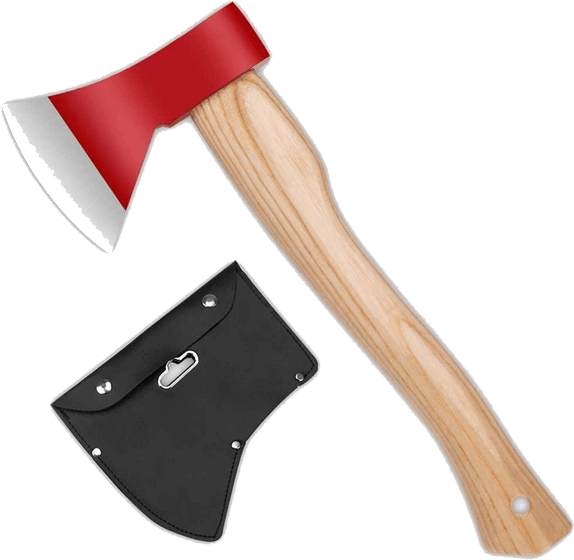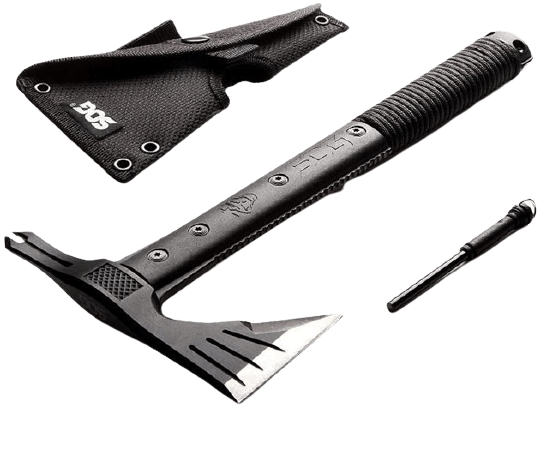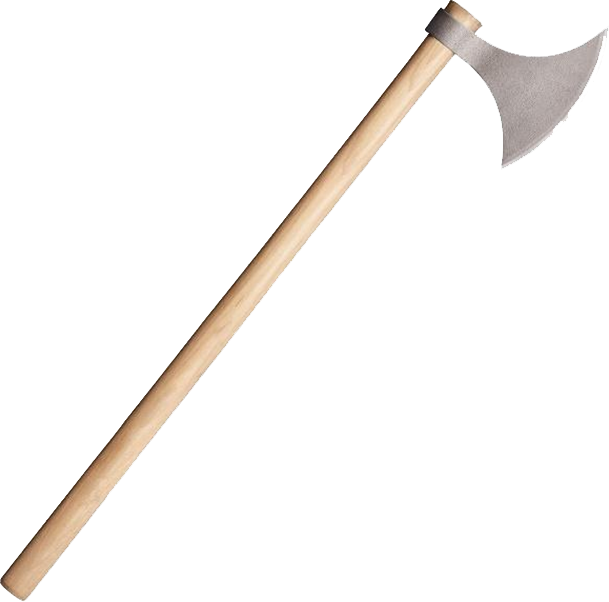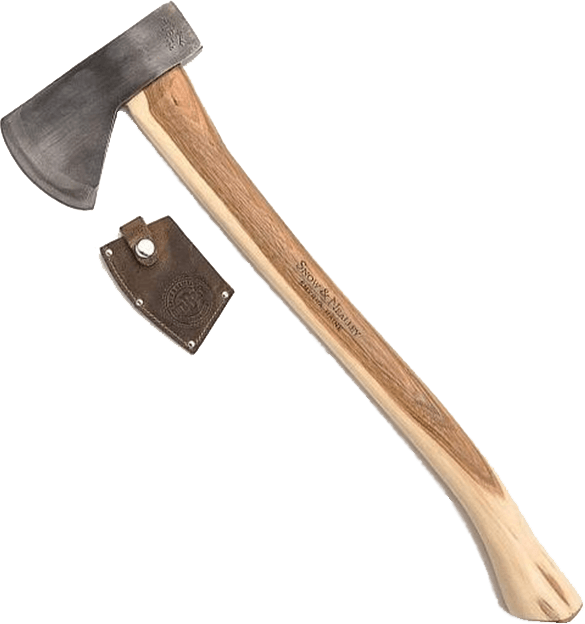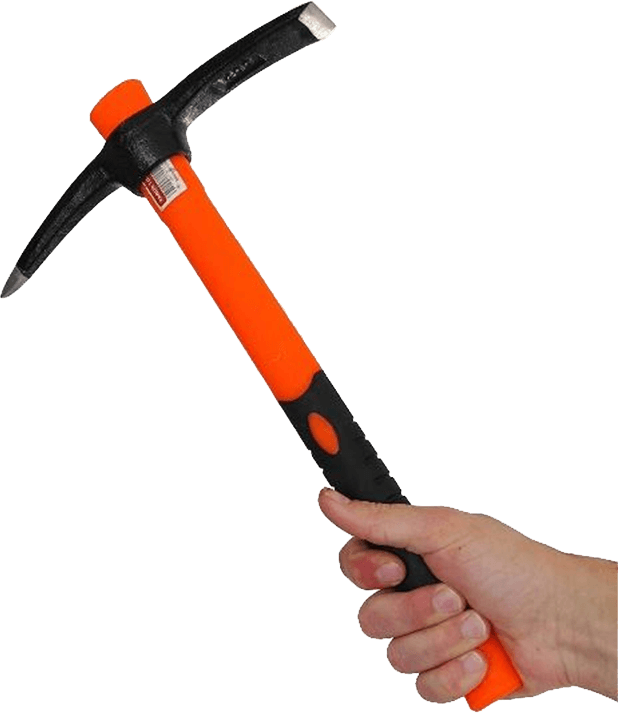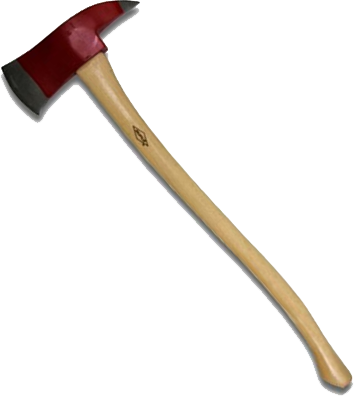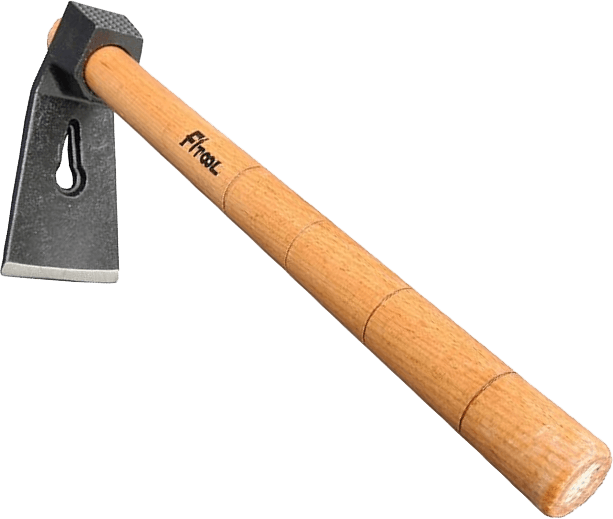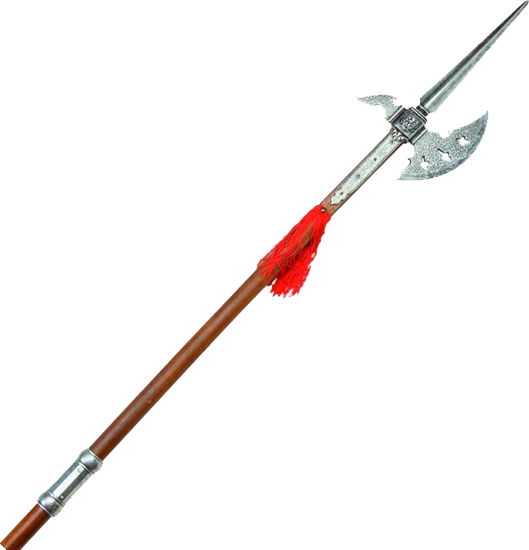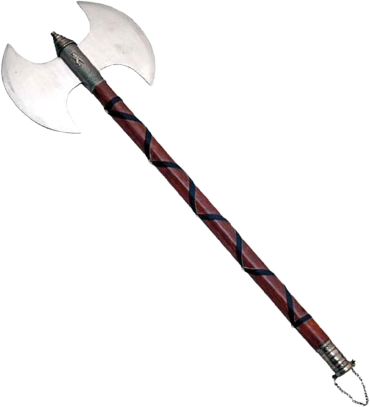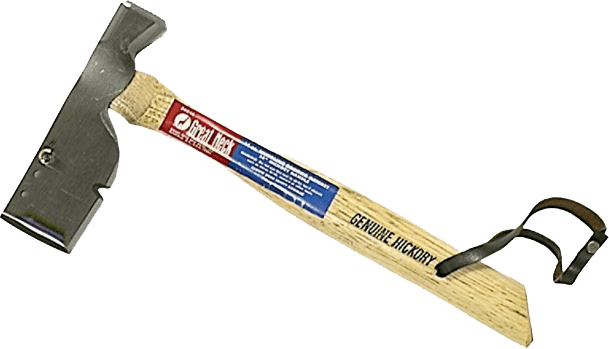People have been using axes since ancient times, but the tool has come a long way since then. Nowadays, we have specialized axes that have been specifically designed for certain applications....
With so many choices, it now becomes a matter of picking the right tool for the job. Some axes are still made to cut wood or for survival, while others can be more accurately described as souvenirs or display items. Here is a long list of the types of axes that you’re likely to encounter.
Quick Navigation
25 Types of Axes
1) Hatchet
A hatchet can be simply described as a small axe designed for one-handed use. Lightweight and compact, hatchets are ideal if you are planning to go on a hike or in any situation where mobility is crucial. It’s also a very versatile tool that can be used in just about any situation that calls for an axe or a knife.

What it’s used for

Features
Our recommendation: Fiskars X7 Hatchet
2) Felling Axe
As the name implies, a felling axe is specifically designed for felling a tree. They have very long handles (28 to 36 inches) and an extremely sharp blade made to across the wood grain. Most felling axes come with wooden handles and a moderately heavy axe head (2.5 to 3.5 pounds)

What it’s used for

Features
Our recommendation: Council Tool Velvicut Premium American Felling Axe
If you need to split firewood, then a splitting maul is the ideal tool. Instead of a sharp edge, a splitting maul sports a wedge-shaped head that weighs about 7 to 12 lbs. This combination of a heavy head and a dull edge rends logs along the grain instead of cutting through them.
Splitting mauls also typically come with a flat hammerhead opposite the cutting edge. This can be used to drive a separate splitter through the log in case the splitting maul alone cannot do the job.
The straight handle allows the user to more smoothly follow through the swing, making it easier to drive the maul deeper into a log. Just like felling axes, the handles of splitting mauls are typically quite long and range from 27 to 36 inches.

What it’s used for

Features
Our recommendation: Husqvarna 32-Inch Wooden Handle Splitting Maul
The double bit axe is a versatile tool, which should be quite obvious given that it has two blades. One blade is kept sharper for cutting across the grain while the blunt edge is more effective for making deep cuts along the grain.
The larger axe head also gives a double bit axe the advantage of more heft. Whether for splitting firewood or felling a tree, the added weight should make the job a little easier. However, this also means that carrying a double bit axe around can be difficult and downright dangerous if not done properly.

What it’s used for

Features
Our recommendation: Helko Werk Traditional Hinterland Double Bit Axe
5) Broad Axe
A broad axe is used primarily for hewing and is characterized by a broad cutting edge with a long beard. Hence, a broad axe is alternatively referred to as a “hewing axe” or “bearded axe.” The flattened blade features a bevel typically only on one side, making a broad exclusively suitable either for left-handed or right-handed use.
A broad axe gains no advantage from swing power, benefitting instead from precise control. Thus, a broad axe typically comes with a short (less than 23 inches) curved handle.

What it’s used for

Features
Our recommendation: Biber Muller Bearded Hewing Broad Axe
6) Tactical Axe
A tactical axe does not have any specific form factor or distinguishing features. Instead, it’s a tool with a singular objective – to aid in survival. Tactical axes are typically small, lightweight, and serve a few different functions. It is a modern take on the traditional axe design with much more focus on its value as a survival tool.

What it’s used for

Features
Our recommendation: SOG Outdoor Survival Hatchet and Tactical Tomahawk
7) Throwing Axe
One may think that any axe can be used for throwing, but that underestimates how much thought goes into designing a proper throwing axe. Throwing axes are very thin for better aerodynamics and come with straight handles that can be tapered down to fit any person’s throwing hand. They also come with very sharp cutting edges, making them easier to stick to target boards.

What it’s used for

Features
Our recommendation: World Axe Throwing League Competition Axe -16-Inch Straight Handle
8) Viking Axe
The axe features prominently in Viking history, both as their most common hand weapon and as a tool for daily life. With their long and thin blades, broad edges, and prominent horns, Viking axes have a unique look that has made them popular for hobbyists and axe enthusiasts.
Although they can also be used to prepare kindling or delimb trees, Viking axes are most often used for display.

What it’s used for

Features
Our recommendation: Cold Steel Viking Battle Axe.
9) Tomahawk
The tomahawk is a traditional weapon and daily tool used by the indigenous people of North America. Classically made with a stone head, modern tomahawks instead use a metal axe head but retain the lean design of the original model.
Tomahawks resemble hatchets and tactical axes because of how compact they are. A straight handle is one of the distinguishing characteristics of a tomahawk, as it makes release easier when throwing. In most cases, tomahawks are also lighter than hatchets.

What it’s used for

Features
Our recommendation: Mouse Hawk Light Throwing Tomahawk
10) Hudson Bay Axe
Named after French explorer Sir Henry Hudson, a Hudson Bay axe is a versatile, one-handed axe historically used by French trappers and hunters. The Hudson Bay axe is characterized by a long cutting edge, a teardrop-shaped eye, and a 22 to 28-inch wood handle.
These are slightly larger than hatchets but are still portable enough to be conveniently used for trips in the bush. It is suitable for chopping small trees or splitting some firewood but isn’t quite as powerful as felling axes.

What it’s used for

Features
Our recommendation: Snow & Nealley Hudson Bay Axe
11) Miner’s Axe
Contrary to what many might think, a miner’s axe is not a pickaxe meant to shatter rocks. Instead, it sports a standard Dayton axe head but comes with a shorter handle no more than 20 inches long. This makes the miner’s axe ideal for use in tight spaces, hence the name. With a tapered cutting edge, the miner’s axe has transitioned from niche use to a more general-purpose tool.

What it’s used for

Features
Our recommendation: Council Tool 3.5-lb. Dayton Pattern Miner’s Axe
12) Pick Axe
A pick axe is a T-shaped axe typically used for gardening or landscaping. It has a distinct axe head that consists of two sides – one with a flat chisel-like edge and another with a pointed pick. The large axe head also provides more power during swinging. Pick axes comes in a selection of lengths and sizes and can be used either one-handed or two-handed.

What it’s used for

Features
Our recommendation: Tabor Tools Pick Mattock with Fiberglasss Handle
13) Dayton Axe
The Dayton Axe is a classic. Easily identified by its bright red axe head, the Dayton Axe is named after the region of Dayton in Ohio. The distinctive red enamel is meant to deter rust in the axe head, giving this axe longevity even in outdoor conditions.

What it’s used for

Features
Our recommendation: Council Tool Dayton Pattern Single Bit Axe
14) Carpenter’s Axe
As the name implies, the carpenter’s axe is a tool made for precise woodworking. It’s compact and can be used one-handed but is slightly bigger. A flat butt which can be used as hammer is another of its distinguishing characteristics.
Control and stability are more important in a carpenter’s axe than power. Thus, the short wooden handle typically has a notch for better grip. The light axe head is compensated for with a very sharp straight cutting edge. Some carpenter’s axes also come with small groove that can be used for nail removal.

What it’s used for

Features
Our recommendation: Gransfors Bruks Carpenter’s Axe
To be clear, there are several types of fireman’s axes. This is the pickhead version – a double bit axe that comes with a sharp cutting edge and a pick-shaped point. This is the tool of choice when firefighters respond to fires in urban areas, such as in houses and buildings.
Pickhead axes aren’t exceptionally heavy but come with long handles ranging from 28 to 36 inches. These are easily distinguishable by red-painted axe heads.

What it’s used for

Features
Our recommendation: Nupla Pick Head Fire Axe with 28-Inch Hickory Handle
16) Adze
A stone age-era tool, the most distinguishing characteristic of the adze is that its cutting edge runs perpendicular to the handle instead of parallel. With a very sharp cutting edge, an adze can be used both for cutting wood and landscaping. Some adzes can also come with a notch for removing nails.
Adzes can be designed either for one-handed (short handle) or two-handed (long handle) use. Adze heads can typically be removed from the handle to facilitate sharpening.

What it’s used for

Features
Our recommendation: Fitool Forged Woodcarving Straight Adze
Another type of fireman’s axe, the Pulaski Axe comes with a large axe head that combines a cutting edge and an adze. In contrast to a Pickhead Axe, the Pulaski Axe is the tool of choice for firefighters responding to wildfires. It has also been used for trail construction in forested areas.
The sharp axe edge is for general cutting work. The adze end is useful when digging through root-infested or hard soil. Most Pulaski Axes used for firefighting come with fiberglass handles for increased weather resistance.

What it’s used for

Features
Our recommendation: Nupla Pulaski Axe with Ergo Power Handle
18) Ice Axe
An ice axe is a specialized tool specifically designed for ice climbing and technical mountaineering in snowy regions. Its main “cutting edge” is a pointed blade with a jagged edge. This is meant to be driven on the ground or ice, at which point the jags dig in and prevent slippage.
Ice axes almost always come with a stainless steel or aluminum handle for durability, an anti-slip grip, and a rope for stashing. The opposite side of the pointed pick can have either a small hammer or adze to make the tool more versatile.

What it’s used for

Features
Our recommendation: Petzl Quark Hammer Ice Axe
19) Halberd
A weapon first used in the 14th century, a halberd can most easily be described as a combination of an axe and a spear. With a typical curved axe blade and a very long pointed head, the halberd had a very long reach that made it ideal for attacking horse-mounted enemies. As halberds are used only for display nowadays, they can come with any number of visual embellishments.

What it’s used for

Features
Our recommendation: Denix Halberd Swiss 17th Century
20) Crash Axe
Crash Axes vary greatly by design by they share a common purpose – as a multi-purpose emergency tool. Typically small and lightweight, a Crash Axe often comes with a short rubber-lined handle and both a serrated and smooth cutting edge. Depending on the brand, a Crash Axe can also be used as a hammer, pick, or pry bar.

What it’s used for

Features
Our recommendation: Gemtor D56 Crash Axe
We thankfully don’t do beheadings anymore, so an Executioner’s Axe is nothing more than a prop or display piece. Typically identified by a large axe head, an Executioner’s Axe can have varying lengths and can be either single bit or double bit. One thing is for certain – an Executioner’s Axe is intimidating not only because of how it looks but also because of the fate of the person unfortunate enough to encounter it.

What it’s used for

Features
Our recommendation: SZCO 30-Inch Medieval Executioner’s Axe
22) Mattock
Often mistaken for a pickaxe, a Mattock is a double bit tool that combines an adze with either a pointed pick or a standard axe cutting edge. This makes the axe head of a Mattock heavier, giving it more momentum and swinging power.
Depending on the specific tool included in a Mattock, it can be suitable for general-purpose digging and chopping. It is usually a two-handed tool to take advantage of the heavy axe head. However, there are also one-handed Mattocks available with shorter handles.

What it’s used for

Features
Our recommendation: Truper 2-1/2 Pound Pick Mattock
23) Roofing Axe
Although no longer as common as they used to be, traditional craftsmen still keep a Roofing Axe handy. Also known as a shingling hatchet, this compact axe a sharp cutting edge, a magnetized hammerhead, and a small notch on the side of the blade. This is called a shingle gauge and is used to ensure that shingles are evenly spaced when placed.

What it’s used for

Features
Our recommendation: Great Neck Roofing Axe
24) Forest Axe
An axe made for the most challenging outdoor conditions, the Forest Axe is an all-purpose heavy-duty cutting tool. It is typically made with some of the most robust materials available including a carbon steel axe head and a Hickory handle. With a very sharp cutting edge and powerful swing, a Forest Axe is perfectly suited for felling trees, cutting up tree limbs, and chopping firewood.
Forest Axes vary greatly from one brand to another but are typically shorter than a felling axe but much larger than a hatchet. While there’s no standard for how a Forest Axe looks like, excellent craftmanship seems to be one of its essential components.

What it’s used for

Features
Our recommendation: Gransfors Bruks Small Forest Axe
25) Battle Axe
While most of us have probably seen battle axes in movies or TV shows, you likely will not see a genuine battle axe outside of a museum. In medieval times, battle axes were weapons that focused on power. They may not have the finesse and reach of a sword, but they can certainly inflict heavy damage. Real battle axes were heavy, cumbersome, and were built to withstand the severe punishment of battle.
Real battle axes varied greatly. They can have a single bit, a double bit, a pointed pick, or all three. These battle axes may have also had ceremonial significance and may be intricately gilded.

What it’s used for

Features
Our recommendation: BladesUSA Medieval Battle Axe with Display Plate
Conclusion
If you’ve only ever used a hatchet before, reading through a list of 25 types of axes may seem very surprising. It’s really quite natural, considering how axes have been useful tools since ancient times. Axes continue to be the tools of choice for many people, including professional lumberjacks and outdoor enthusiasts, despite the presence of more modern alternatives.

Carlo’s introduction to the wilderness was during his stint in geothermal and geological surveying, which brought him to remote and unusual hiking spots all over Southeast Asia. His outdoor experience has made him an expert in axes and other types of saws.


